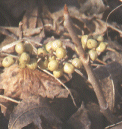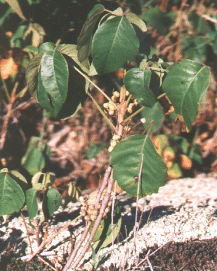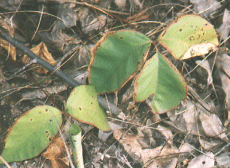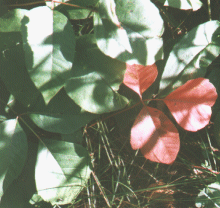|
|
 |
|
A highly variable perennial woody vine or shrub, native to North America and Asia and introduced in Great Britain, Europe, and Australia.
There is considerable disagreement over whether poison ivy is one species with variations, or many separate species. It is also sometimes said that the poison oaks (Toxicodendron diversilobum and Toxicodendron quercifolium) are merely variations of the same species. The photos on this page depict the common form in my locale (a trailing vine), but the text is more general.
Poison ivy prefers rich soil with good drainage and plenty of water. It is particularly common around lakes, swamps, and rivers. It will grow perfectly well, however, in a wide variety of other habitats. It's common along roadsides and trails, in areas of waste ground, in thickets, in open woods, and in old fields. It seems to do best in my area (Minnesota) in places that are just slightly shaded. New poison ivy shoots sprout from existing roots, from rhizomes (underground stems), from climbing vines, and of course, from seed. The stems are woody, brown, and smooth (though older stems of climbing plants develop a very hairy appearance). They may trail along (or just under) the ground, sending frequent branches both out and up. They may grow upright, in a shrub form, which can reach 7 feet in height under good conditions. Or they may grow as a vine, up to 5 inches in diameter, climbing trees and fences by means of dense, dark, fibrous, aerial roots (giving the vines that hairy look). |

The alternate leaves have rather long stalks and are palmately compound (the leaflets radiate outward from a center point, like the fingers on your hand). The three leaflets, around 2" to 4" in length, may be shiny or not, are generally (but not always) wavy-edged or slightly toothed, and are sometimes slightly lobed. The young leaves are green, often with a reddish cast that they lose as they mature. In late spring to early summer, the flowers appear, in loose clusters from the leaf axils. The flowers have five petals, are about 1/8" diameter, are off-white with a yellowish or greenish tinge, and develop into small (about 1/4" diameter), round, dry, off-white fruits with a yellowish or greenish tinge. The fruit ripens in late summer through late fall, and at about the same time the leaves turn bright red, providing a cue to the many birds that feed on the fruits. The leaves fall once temperatures drop below freezing, while the fruits remain on the plants through the winter. The thing that makes poison ivy so famous is the presence of a pale yellow oil called urushiol. This oil is present within all parts of the plant, but is not found on the surface unless the plant is damaged or bruised. The plant is somewhat fragile, however, and the majority of specimens are damaged in some way. Furthermore, urushiol can take many years to break down, particularly in cool and dry conditions, so it is also present in dead plants. Urushiol is sticky, and is easily transferred to anything that touches it. And, as it is a stable compound, once it's on something (like your clothes, tools, or pets), at least some of it will stay there for quite a while unless it's washed off. When poison ivy is burned, the urushiol is carried on particles of soot and dust in the smoke. Urushiol itself is not poisonous. However, urushiol which remains on your skin for more than five minutes or so will begin to be absorbed and metabolized. |

The metabolites bind with skin proteins, forming new structures. In about 85% of the human population, the immune system sees these structures as foreign and attacks them. It is this immune response, or allergic reaction, which causes the itching, inflammation, and blistering of the skin. These symptoms generally appear after half a day to two days. After a few more days, when all of the alien structures have been destroyed (along with much of the surrounding tissue), the rash begins to heal... The average person doesn't have a reaction the first time they're exposed, and if they do, it's usually delayed by seven to ten days. It takes some time for your body to produce the appropriate T-cells. Sensitivity also varies among individuals, and usually decreases with age. The palms of the hands and the soles of the feet, where the skin is thicker, are generally immune. Severe cases, especially those involving mucous membranes (eyes, mouth, throat, lungs, etc.) require medical attention. Hydrocortisone preparations or, in really severe cases, steroids, are generally given to reduce the immune response. As with many allergens, a severe reaction can be fatal if left untreated. |

The best way to avoid getting "poison ivy" is to not get urushiol on your skin. Know what the plant looks like and avoid it. If you can't avoid it, wear protective clothing. Wash anything that may have come in contact with the plant before it touches your skin, including your dog. Never ever ever burn poison ivy. Stay away from forest fires (unless you're a firefighter, then wear protective gear). There are also barrier creams that are commercially available. If you think you've been exposed, wash the area as soon as possible, preferably within an hour after exposure, with lots of cool running water. A lake or a river works well. Don't use soap unless it contains no oils (oil will cause the urushiol to spread). In the woods, look for bouncing bet (Saponaria officinales). With its high saponin content, it makes a workable oil-free soap. You may also wash the area with alcohol or another solvent, rinsing with plenty of water, but keep in mind that this strips your skin of its protective oils, making it more vulnerable to urushiol. The most well known herbal treatment for poison ivy is the juice of jewelweed (Impatiens spp.) There may be a compound in jewelweed which binds to the same sites as the urushiol metabolites, thereby blocking their access. If this is true, applying jewelweed to the skin just before or just after exposure should prevent the rash. There is quite a lot of anecdotal evidence that this works. Jewelweed also has anti-inflammatory properties and should be a soothing treatment for an already developed rash. Plantain (Plantago spp.), applied as a poultice, may also prevent the rash and will also soothe an already developed rash. Other plants with astringent and/or soothing properties may also help. There is anecdotal evidence of people desensitizing themselves to poison ivy by eating poison ivy leaves, first starting with a tiny amount and then gradually increasing the dosage until a maintenance level is reached. The most common side effect of this treatment, however, is getting the rash where the urushiol passes out of your body. It is also possible to have symptoms internally. Similar treatments in pill form can be obtained from a doctor or dermatologist, but have the same unpleasant side effects. No other immunization appears to be available at this time. Medicinally, poison ivy has been used to treat paralysis, arthritis, and certain persistent skin disorders, and also as a sedative. It is still used in homeopathic medicine for arthritis and skin disorders. Poison ivy fruits are an important food source for a wide variety of birds (who also spread the seeds), and also for other wildlife, including deer. Goats quite like poison ivy and can be an effective means of controlling it. I've heard that drinking the milk from such a goat might desensitize a person, though I haven't seen any evidence to back that up. Studies have been done showing that urushiol is not transferred to the milk, but whether its metabolites are present seems to be unknown. Poison ivy has occasionally been planted in gardens for color. This is how it arrived in England and Australia. The sap turns black, and dries hard (like lacquer), when exposed to air, and has been used as a permanent ink, as a dye, and as an ingredient in varnishes. To control poison ivy, either pull or dig it out by hand, cover it with mulch so that no light reaches it, mow it close to the ground, spray it with herbicides, or use any combination of methods. If you pull it out by hand, the best time is probably late fall or very early spring, and protective clothing must be worn. Be sure to get every part of the plant or it will regenerate. Throw it all in the trash (double bag it for the trash collector). Do not attempt to compost it and never ever try to burn it. When you're finished, wash everything, including yourself, thoroughly (wash your clothes separately from your other laundry or have them dry-cleaned if necessary). Using mulch is simple, but the ivy may pop through again, so cover it well. Mowing will kill a portion of it, anyway, as will the exposure to full sun, but remember that you're getting the oil all over the place, so wear protective gear and clean your equipment afterward. If herbicides are used, use them carefully, following the directions, and no more than necessary. Probably the most effective and least harmful method is to cut it and then use a disposable foam brush to paint the stump with the herbicide. You'll probably also want to wash everything when you're done. Herbicides are poisons, after all. One last way to control poison ivy is to make the site inhospitable for it. Pay attention to the local conditions that it likes to grow in, and those it doesn't grow in, and then add or remove other plants to make the poison ivy feel less at home. Planting aggressive plants or plants that inhibit the growth of other plants, like black walnut or mugwort might be worth a try. A last thought - don't create a problem where none exists. Behind the building where I work, there's a granite outcropping covered in wild blackberries, wild roses, staghorn sumac, moss with tiny little flowers and poison ivy. Small animals and birds loved the place, as did I, often picking blackberries there (carefully) on my lunch break. The poison ivy never spread off the rock because the area around it was kept mowed. But some safety official from the big city decided it was dangerous and had to be eliminated, so our maintenance crew has been spraying Round-up all over it for months and months. They haven't killed the poison ivy - and probably won't, even if they try to dig it out, since the roots run through the rock, but they've killed almost everything else there - there are no more blackberries, no roses, no birds or rabbits or tiny little flowers - and as far as I know noone ever actually got poison ivy there because only a few of us ever went back there and we were all nature types who knew enough to avoid it. It's just a waste of time, energy, and much needed habitat to start a war against something that isn't hurting anyone. *** -- Buy Plantain Ointment online! -- ***
Selected References
|
|
| Home | About this site | Asides/Glossary | Store |
| Taxonomy Tree | Species list | Article list | |
|
Featured sponsors:
|
Mountain Rose Herbs Bulk herbs, teas, oils, & much more! |
Richter's Herbs Seeds & plants |
|
|
© 1999-2015 by Deb Schwartz. All rights reserved. Please send feedback to: deb@kingdomplantae.net Website by ki-yi.com
|
|||